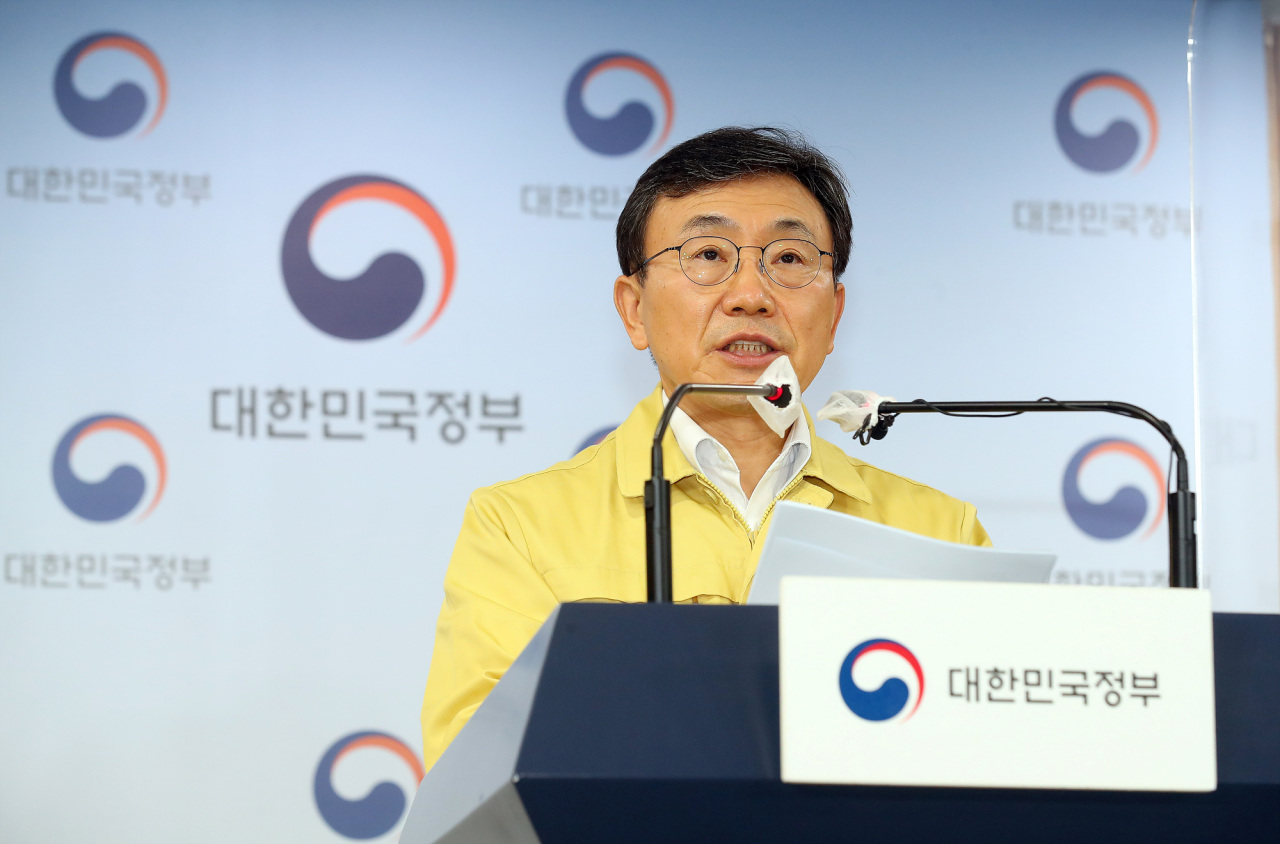
South Korean Minister of Health and Welfare Kwon Deok-cheol speaks during a news briefing Friday. (Ministry of Health and Welfare)
More than a year and nine months into the COVID-19 crisis, Korea is set to gradually move on from its touted success formula in containing the pandemic.
The government’s COVID-19 response headquarters reiterated on Friday that from Nov. 1, Korea would push ahead with its plan to get back to normal over three phases, each lasting four to six weeks.
Minister of Health and Welfare Kwon Deok-cheol told the news briefing that a high public compliance has allowed Korea to clear its goal of fully vaccinating 70 percent of the population early, and that the widespread vaccination’s impact on hospitalizations and deaths was already apparent.
After dropping the nightly curfews on businesses next week, the limit on the size of social gatherings will be further eased upon reaching the full vaccination rate of 80 percent, he said. In the third and the last phase of the return to normal, all restrictions facing businesses and personal interactions would end.
Along with the easing of social distancing restrictions, contact tracing will be simplified and the mandatory quarantine period for close contacts of patients cut from 14 days to just 10. At-home care will replace community treatment centers, which are nonhospital facilities dedicated to isolating and caring for patients with mild or no symptoms.
The changes coming into effect from November mark a departure from Korea’s unique response measures that made the country a COVID-19 success story, and medical experts say they are worried.
Infectious disease expert Dr. Lee Jacob, who is advising the government on its COVID-19 policies, said for one thing, the proposed timeline is rushed.
During a conference held Monday, Lee was careful to endorse the road map for restoring normal in three months. “If Koreans are led to believe normal can return in two to three months, they are going to be disappointed,” he said.
While the government set the bar for reintroducing the restrictions as 80 percent full intensive care beds, that was “too risky,” Lee said, calling for it to be lowered. “Waiting until 80 percent of intensive care beds around the country are filled up is not going to be safe,” he said.
The conditions for activating the contingency plan was adjusted from an intensive care bed occupancy rate of 80 percent to 75 percent in Friday’s version. But what the backup strategy might entail for hospitals is still missing, according to front-line medics.
Dr. Kim Hyoung-soo, a thoracic surgeon heading the Hallym Sacred Heart Hospital’s ECMO center for severely or critically sick COVID-19 patients, said preparations were lacking for a potential surge of an unprecedented scale as the country ventures toward normal.
He said measures should be drawn up in advance “to avoid a scenario where hospitals are ordered to empty beds to take in COVID-19 patients, like it had been the case at past points in the pandemic.”
On the bright side, he said that compared to this summer when the vaccination campaign had yet to reach the general public, patients being admitted now were at least partly vaccinated and tended to fare better.
On using intensive care availability as the yardstick for measuring health care capacity, infectious disease specialist Dr. Eom Joong-sik of Gachon University Medical Center, a government-designated COVID-19 hospital in Incheon, said that “bed counts do not properly reflect what actually goes on at hospitals.”
He pointed out that even at the height of the influx of intensive care COVID-19 patients that left hospitals scrambling and health care workers burned out in August, the occupancy rate was around 70 percent.
In a bid to relieve the burden on health care systems, the government made at-home care the default arrangement for patients who are younger than 70 and without severe symptoms, but Eom urged caution.
In less than a month since the home care scheme’s expansion, a patient in his late 60s had died before he could receive hospital care. Eom said that the deceased patient being at risk by age and unvaccinated status should have disqualified him from staying home to recover.
“The criteria for the at-home option needs to be tightened or else it’s going to cost more lives unnecessarily,” he said. Currently even older, unvaccinated patients can be prescribed home care if they have mild symptoms at the time of diagnosis.
To make home care safer, the government said it aims to purchase enough oral antivirals to treat up to 400,000 patients. But no deal has been finalized yet, and the drugs aren’t set to become available here until January.
As Korea’s vaccine feats and the subsequent reopenings are celebrated, the potential perils of reclaiming normal was not coming into focus as much, Eom said.
“Before celebrating the freedoms that will be brought back, through a public conversation, a society-wide understanding and consensus should be established that some compromises in safety are the necessary trade-off for more freedoms.”
By Kim Arin (
arin@heraldcorp.com)






![[Graphic News] More Koreans say they plan long-distance trips this year](http://res.heraldm.com/phpwas/restmb_idxmake.php?idx=645&simg=/content/image/2024/04/17/20240417050828_0.gif&u=)